|
|
|
Sort Order |
|
|
|
Items / Page
|
|
|
|
|
|
|
| Srl | Item |
| 1 |
ID:
167640


|
|
|
|
|
| Summary/Abstract |
This article investigates whether the People’s Republic of China and Japan perceive each other as rivals in Latin America (LA; both the Chinese and Japanese governments tend to refer to the region as Latin America and the Caribbean (LAC), but for the purposes of this article we focus mainly on LA), and what impact such a perception might have on their foreign policy decision-making. We take LA as a case study because China’s and Japan’s recent (re-)engagement there began almost simultaneously in the early 2000s, and has developed against the background of domestic leadership transitions, growing demands for energy and markets, as well as international political agendas in which LA might play a key role. Developing the work of Thompson [(1995). Principal rivalries. Journal of Conflict Resolution, 39 (2), 195–223; (2001). Identifying rivals and rivalries in world politics. International Studies Quarterly, 45(4), 557–586] and Vasquez [(1993). The War Puzzle. Cambridge, MA: Cambridge University Press; (1996). Distinguishing rivals that go to war from those that do not: Aa quantitative comparative case study of the two paths to war. International Studies Quarterly, 40 (4), 531–558] on rivalry, in combination with perception theory [Jervis, R. (1976). Perception and misperception in international politics. Princeton, NJ: Princeton University Press], the article suggests three indicators by which to measure the extent to which China and Japan might perceive each other as rivals. Drawing on content analysis of a range of Chinese- and Japanese-language official writing, news reports, and academic analysis, the article argues that, despite some media representation of China and Japan as competitors for resources and power in LA, in fact mutual perceptions concerning rivalry have not affected LA policy decisions of these two countries.
|
|
|
|
|
|
|
|
|
|
|
|
|
|
|
|
| 2 |
ID:
167638
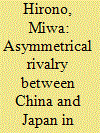

|
|
|
|
|
| Summary/Abstract |
To what extent is China–Japan rivalry a global phenomenon, and what is the nature of the rivalry they engage in outside their own region? Literature on Sino-Japanese rivalry abounds, but it pays scant attention to the relevance of the rivalry outside East Asia. This article argues that Sino-Japanese rivalry has indeed become a global phenomenon, that various forms of the rivalry are evident in Africa, and that they are mostly of an asymmetrical nature. Quantitatively, China’s contribution to Africa is far greater than that of Japan, with the exception of foreign direct investment (FDI). Qualitatively, though, Japan has a stronger sense of the rivalry than China has, revealing a psychological aspect to the asymmetry as well. Contextually, the types of activity that Chinese and Japanese actors carry out in Africa are not necessarily the same, which makes the rivalry all the more asymmetrical. The rivalry has become more apparent recently, not only because of the rise of China but also because of a change in the meaning of ‘Africa’ – from a region of ‘poverty’ and ‘hunger’ to a region of ‘economic opportunities’. That said, Africa – to a greater or lesser degree in each of its countries – still suffers from conflict and instability. As a result, the ability of Japan and China to exert power and influence throughout Africa is somewhat restricted.
|
|
|
|
|
|
|
|
|
|
|
|
|
|
|
|
| 3 |
ID:
167636
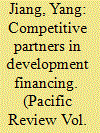

|
|
|
|
|
| Summary/Abstract |
In the aftermath of the global financial crisis, with the world in search for new economic engines, China and Japan have explicitly given their answer through their expansion of overseas infrastructure investments. This study focuses on the flagship sector of high-speed railways (HSR) and examines what kinds of development financing China and Japan have adopted in making these investments. It asks the following questions: What similarities are there in the Chinese and Japanese approaches to investments in overseas infrastructure, and how do they differ from traditional Western development financing? Also, in what ways have China and Japan changed their approaches to overseas infrastructure projects during this process? It argues that in the process of expanding overseas infrastructure investments and competing for infrastructure projects, China and Japan have become ‘competitive partners’ in challenging the traditional norms of development financing represented by the Washington Consensus and the Development Assistance Committee (DAC). To be more specific, China and Japan have adopted each other’s practices of tied commercial financing, heavy government involvement, focusing on physical infrastructure and industrialization, and showing respect for host-country forms of governance. In particular, by joining China in the new game of exporting infrastructure and through its own ‘quality infrastructure investment’ initiative, Japan has broken out of the constraints of DAC norms as an aid donor and endorsed some fundamental Chinese approaches to development and development cooperation, which in their turn were inspired by earlier Japanese practices.
|
|
|
|
|
|
|
|
|
|
|
|
|
|
|
|
| 4 |
ID:
167634


|
|
|
|
|
| Summary/Abstract |
This special issue analyzes the evolving notion of Sino–Japanese rivalry and its effects on concrete foreign policy measures of both states in a global context. China’s emergence as a great power and Japan’s attempts to ‘normalize’ its foreign relations took place alongside both countries increasing their political engagement in world regions beyond Northeast Asia. As a result, there has been increasing mutual monitoring of and increasing concern expressed about the intentions and actions of the respective other on these different levels of world politics. This has largely been neglected in the literature. This special issue closes the gap in the literature by providing answers to the following questions: Is there a Sino–Japanese rivalry in the first place? Which factors define this rivalry? Are there different levels and/or kinds of rivalry? Which factors influence Sino–Japanese rivalry in different regions and on different levels of the international system? Do these factors differ across regional and institutional boundaries? Answering these questions requires us to conceptualize what is meant by rivalry as well as to focus on Sino–Japanese interaction in different world regions and on the level of international institution building. This special issue also contributes to the literature on interstate rivalry by challenging common understandings of the concept of rivalry and by adding new facets and interpretation of rivalry based on the concrete empirical cases. It will therefore provide a broadened perspective on the characteristics of Sino–Japanese relations, the mutual impacts of Japan’s and China’s globalizing foreign policies, and on our understanding of the determinants and mechanisms of interstate rivalries.
|
|
|
|
|
|
|
|
|
|
|
|
|
|
|
|
| 5 |
ID:
167639
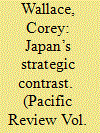

|
|
|
|
|
| Summary/Abstract |
Since 2008 the Japanese government has become more responsive to the exercise of Chinese economic, diplomatic and military power in Southeast Asia, suggesting an intensifying rivalry. The Japanese government has thrown off any reticence about self-promotion by more forcefully positioning Japan as a sensitive and sustainable strategic partner for Southeast Asian nations in a strategic contrast with the People’s Republic of China (PRC). Rather than trying to contain China, Tokyo is seeking to mediate how China turns its material resources into influence. Despite an increasing asymmetry in material resources between China and Japan, this article argues that Japan maintains a surprising ability to influence the preferences of Southeast Asian nations and responses to exercises of PRC power, which in turn has allowed Japan to influence China’s regional strategy.
|
|
|
|
|
|
|
|
|
|
|
|
|
|
|
|
| 6 |
ID:
167635
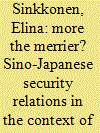

|
|
|
|
|
| Summary/Abstract |
This paper analyses the evolution of Sino-Japanese rivalry in the security sphere concentrating on the Chinese perspective, and placing it within the wider context of complex interstate rivalry between China, Japan and the United States. From a theoretical viewpoint, this research contributes to the literature on interstate rivalry from multiparty perspective, which has been overlooked in existing research. China–Japan–US complex interstate rivalry includes elements of positional, spatial and ideological rivalry simultaneously. When rivalries mix two or more rivalry types, they become more difficult to resolve. The two broad trends of China’s military build-up and deepening US–Japan alliance evolve in tandem intensifying rivalry dynamics and increasing positional elements of rivalry. There are many indications on various levels that for China, controlling Japan’s international ambitions has become less important and more attention is paid to ways in which Japan helps the United States in reaching its objectives in Asia through their alliance agreement. The cases analysed to display complex interstate rivalry include the Taiwan question, territorial disputes in the East and South China Seas, and the North Korean nuclear issue.
|
|
|
|
|
|
|
|
|
|
|
|
|
|
|
|
| 7 |
ID:
167637
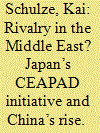

|
|
|
|
|
| Summary/Abstract |
Ever since the so-called rise of China has started, Sino-Japanese relations have been increasingly described as a rivalry between both states. For the most part, this assumed rivalry has been analyzed on the global level or within the boundaries of the East Asian region, while the consequences of this rivalry for other world regions, such as the Middle East, have been largely neglected in the literature. In order to fill this gap, this article investigates how China’s growing presence in the Middle East, and in particular regarding the Israeli-Palestinian conflict, influences Japan’s own foreign policy in this troubled region. It utilizes a modified concept of the strategic rivalry approach, called ‘asymmetric rivalry’, which challenges the widespread notion that rivalry needs to be mutually perceived by both sides and thus analyzes the assumed Sino-Japanese rivalry in the Middle East from a Japanese perspective. By focusing on the case of Japan’s CEAPAD initiative, which aims at coordinating East Asian countries’ developmental assistance towards the Palestinian Authority while deliberately excluding China, the present article shows that the perception of Japan’s foreign policy elite of China as a rival decisively influences how Japan’s foreign policy is shaped in the context of the Israeli-Palestinian conflict.
|
|
|
|
|
|
|
|
|
|
|
|
|
|
|
|
|
|
|
|
|